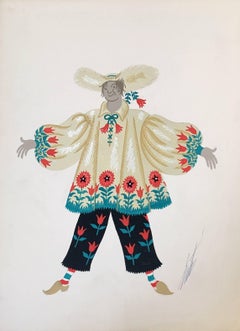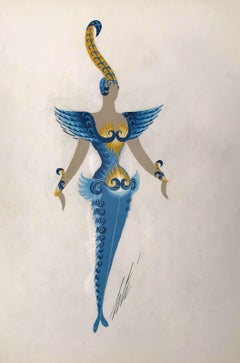Erté Art
Born Romain de Tirtoff (1892–1990) in St. Petersburg, Russia, to an aristocratic family, the artist known as Erté — a pseudonym derived from the French pronunciation of his initials — was a Renaissance man of the art and design world. He worked in graphic arts, interior design, fashion, jewelry and set design for the stage and silver screen, becoming a leader of the Art Deco style.
Moving to Paris in 1912, Erté worked as a fashion designer under couturier Paul Poiret before securing a job with Harper’s Bazaar as a cover artist. Over 22 years, Erté created more than 240 magazine covers alongside his ongoing work in fashion design.
Extending his prolific career into theater sets, costumes, prints and lithographs, Erté became one of the most famous artists of the era. His style — a combination of the nature-inspired flourishes of Art Nouveau and bold, geometric linework — directly contributed to the birth of Art Deco, earning him the nickname “the Father of Art Deco.”
After a lull of creative production in the 1940s and 1950s, Erté reentered the public eye in the 1960s, when a renewed interest in Art Deco had taken shape.
Creating colorful lithographs, bold serigraphs (silk-screen prints) and bronze sculptures, he contributed to a resurgence of the style in France and beyond. This late-life acclaim for his art led to exhibitions in museums and galleries all over the world as well as his first published monograph in 1970. That same year he was awarded the title of Chevalier du Mérite Artistique et Cultural and in 1976 was named Officier des Arts et Lettres by the French government.
Today, Erté’s works are in the collections of the Metropolitan Museum of Art and the Cooper Hewitt, Smithsonian Design Museum, in New York, the Victoria and Albert Museum in London and LACMA in Los Angeles.
On 1stDibs, browse a collection of Erté art, including fine art prints, paintings and other works.
1920s Modern Erté Art
Screen
1950s Modern Erté Art
Gouache
1950s Modern Erté Art
Gouache
1950s Modern Erté Art
Gouache
1950s Modern Erté Art
Gouache
1950s Modern Erté Art
Gouache
1970s American Modern Erté Art
Screen
1990s American Modern Erté Art
Screen, Giclée
1950s American Modern Erté Art
Board, Gouache
Late 19th Century Modern Erté Art
Gouache
20th Century Modern Erté Art
Gouache, Paper
1930s American Modern Erté Art
Watercolor, Gouache, Board
1950s American Modern Erté Art
Screen
1970s Modern Erté Art
Gouache
1960s Modern Erté Art
Acrylic, Gouache, Permanent Marker, Mixed Media
1930s American Modern Erté Art
Gouache, Oil, Board
1980s American Modern Erté Art
Screen
1930s American Modern Erté Art
Paper, Gouache
1950s Modern Erté Art
Gouache
1950s Modern Erté Art
Gouache
1950s Modern Erté Art
Gouache
Mid-20th Century Modern Erté Art
Gouache
Erté art for sale on 1stDibs.
Artists Similar to Erté
- What is Erté art?1 Answer1stDibs ExpertApril 5, 2022Erté is a pseudonym for Romain de Tirtoff, an artist who created glamorous illustrations of prosperity and luxury. The clean lines and geometric patterns took inspiration from Japanese prints and Greek pottery. Shop a selection of Erté pieces from some of the world’s top art dealers on 1stDibs.
- 1stDibs ExpertApril 5, 2022Romain de Tirtoff, best known under the pseudonym Erté, is a Russian-born French artist best known for art deco style. Erté worked in a wide array of fields, influencing fashion, costume and interior decor. Erté secured a contract with Harper’s Bazaar in 1915 where he produced fashion illustrations that are still highly coveted by collectors today. Browse a range of Erté work on 1stDibs.







